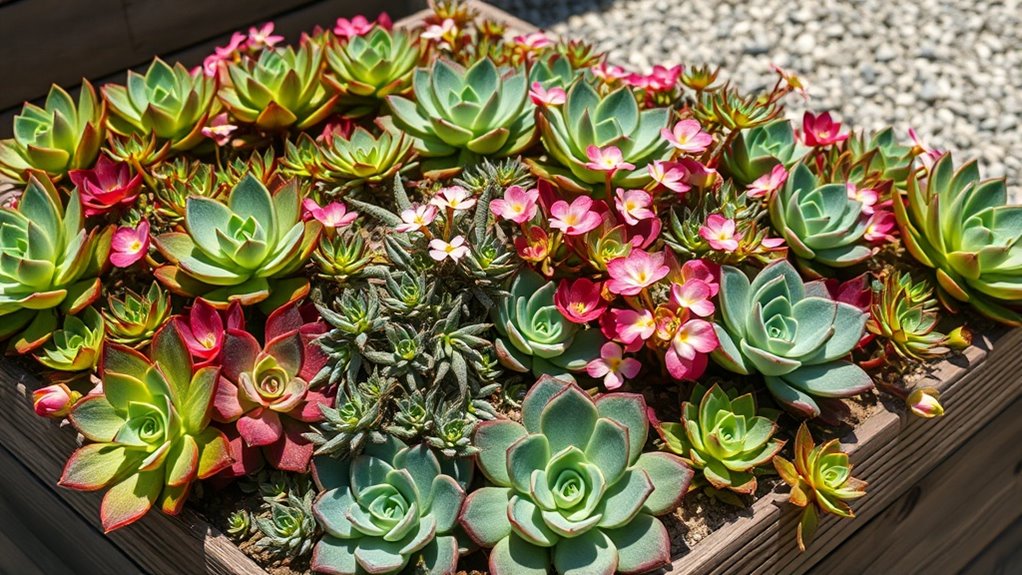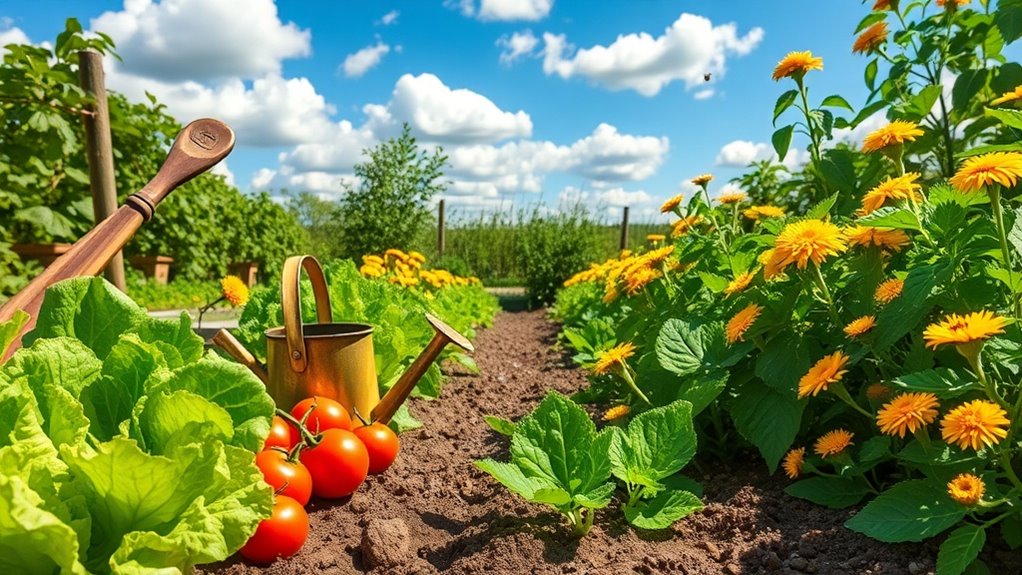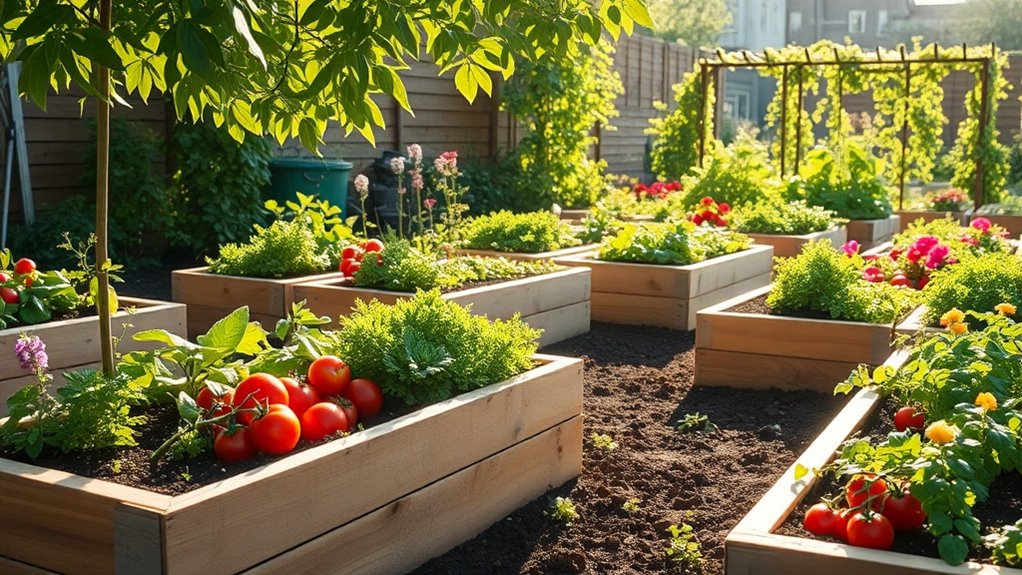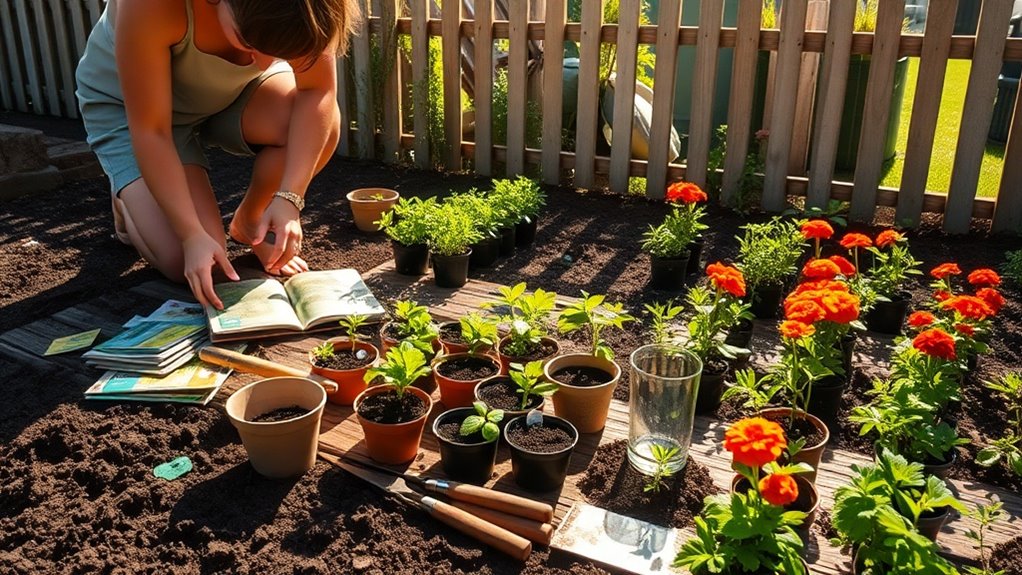This Watering Schedule Changed My Entire Garden Game
You’ve likely battled wilting plants from outdated watering routines, but this breakthrough schedule changes your garden game entirely. It syncs with your plants’ natural rhythms, using tools like moisture meters for precise hydration and heat-proof strategies to avoid overwatering. You’ll foster deeper roots, vibrant growth, and drought resistance, turning your space into a thriving paradise. Check out the steps and tips to tailor it perfectly for your setup.
Key Takeaways
- Implement a watering schedule that aligns with plants’ natural rhythms to prevent overwatering and promote healthier growth.
- Use tools like soil moisture meters and soaker hoses for precise monitoring and efficient water distribution.
- Adopt deep watering techniques to encourage deeper roots, enhancing drought tolerance and overall plant resilience.
- Adjust schedules based on weather, soil type, and sunlight to maintain optimal hydration and reduce plant stress.
- Experience improved garden vitality, with reduced pests and vibrant blooms, through consistent and automated watering routines.
The Breakthrough Watering Schedule That Transformed My Garden
When you implement this breakthrough watering schedule, your garden can flourish like never before. This method focuses on efficient watering by syncing it with your plants’ natural rhythms, ensuring every drop counts. This schedule also includes heat-proof tips to help your garden thrive during scorching weather.
You’ll monitor soil moisture precisely and water only when needed, using tools like moisture meters for accuracy. Active adjustments based on weather patterns optimize hydration, promoting deeper roots and healthier growth.
By avoiding common mistakes like overwatering, you’ll enhance your garden’s overall vitality and longevity.
Why Traditional Watering Methods Fall Short
Traditional watering methods often overlook your plants’ unique needs, leading to overwatering or underwatering that stresses them unnecessarily. In contrast, adopting an innovative watering schedule can address these issues effectively.
These methods rely on rigid, one-size-fits-all schedules that ignore factors like soil type, weather fluctuations, and plant-specific demands, resulting in poor water absorption and root issues.
Consequently, you’re left dealing with stressed plants showing yellowing leaves, wilting, or increased vulnerability to pests and diseases.
This inefficiency wastes water and resources, frustrating your efforts and diminishing overall garden health, proving these approaches unreliable for achieving vibrant, sustainable results.
However, by implementing watering timing strategies from proven gardening insights, you can enhance plant growth and conserve water more effectively.
Step-by-Step Implementation of the New Routine
You’ll begin by planning your watering schedule based on your garden’s specific needs and conditions. To enhance this process, incorporate DIY Watering Hacks inspired by effortless gardening methods for reduced maintenance time.
Next, execute the routine steps with precision to maintain optimal hydration.
Finally, monitor your plants’ responses and adjust the schedule to address any issues promptly.
Moreover, by adopting deep watering, you can reduce watering frequency to once a week while ensuring soil moisture reaches the roots for optimal plant growth.
Plan Watering Schedule
Once you’ve assessed your garden’s specific needs, you’ll begin planning a watering schedule by following these straightforward steps to ensure efficient, plant-friendly results.
First, categorize plants by their water requirements, grouping high-needs species separately.
Next, evaluate environmental factors like soil type, sunlight, and seasonal weather to determine baseline frequencies.
Then, calculate watering intervals—such as every two to three days—based on these insights.
Finally, outline a weekly calendar, noting specific days and durations to avoid overwatering.
This structured approach keeps your garden thriving without guesswork.
Execute Routine Steps
With your watering schedule in place, you implement it by starting with a daily check of soil moisture to confirm when plants need water.
Then, gather your tools like a hose or can, and water each plant according to the planned frequency and volume.
Apply water directly to the soil base for efficient absorption, avoiding foliage to prevent issues.
For larger gardens, divide areas and tackle them sequentially, ensuring even coverage.
Stick to the routine’s timing, such as early mornings, to maximize uptake and plant health.
Consistency drives success here.
Monitor and Adjust
Effective monitoring and adjusting of your watering schedule ensures optimal plant health and efficiency. You’ll regularly check soil moisture using a meter, observe plant responses like wilting or yellowing, and tweak your routine based on weather or seasonal changes. Here’s a quick guide to help:
| Monitoring Factor | Adjustment Action |
|---|---|
| Dry Soil | Increase frequency by 1-2 days |
| Wilting Plants | Add water immediately |
| Over-Saturated Soil | Skip next session entirely |
Essential Tools for Efficient Watering
To keep your garden thriving without waste, you’ll need a few key tools for efficient watering.
These essentials ensure precise delivery, saving time and resources while promoting optimal hydration. Incorporating these tools can help adapt your watering routine to seasonal changes, ensuring your garden thrives year-round.
-
Watering can: Use this for spot watering, allowing you to target plants directly and avoid oversaturation.
-
Soaker hose: Lay it out for slow, even moisture distribution at the root level, reducing evaporation.
-
Drip irrigation system: Install it to deliver water drop by drop, conserving usage and preventing runoff.
-
Soil moisture meter: Check soil conditions quickly to water only when necessary, enhancing efficiency.
For the watering can, consider watering tool tips to ensure you select one that suits your garden’s specific requirements.
Surprising Benefits for Plant Health and Growth
While proper watering might seem routine, it delivers surprising benefits that boost your plants’ health and growth, such as enhanced root systems and increased resistance to pests. As highlighted in plant revitalization strategies, adjusting your watering schedule can help uncover misconceptions about daily practices that might hinder optimal growth.
Consistent hydration promotes deeper roots, enabling better nutrient absorption and drought tolerance, which strengthens your garden’s foundation.
You’ll also see improved photosynthesis, resulting in vibrant leaves and prolific flowering.
By optimizing water delivery, you minimize plant stress, enhancing overall vigor and disease defense.
This method ensures your plants thrive with greater resilience, transforming your gardening efforts into a success story.
However, to maintain these benefits, it’s essential to recognize signs of overwatering that could undermine plant health.
Real-World Examples From My Backyard
You’ll find my backyard success stories illustrate how a tailored watering schedule boosts plant vitality.
For example, these real-world plant growth examples show tomatoes thriving with consistent morning hydration.
Now, use these insights to optimize your own garden’s health. Additionally, incorporating automated systems can help keep your garden thriving even when you’re away.
By applying seasonal strategies, you can adapt your watering routine to different weather conditions throughout the year.
Backyard Success Stories
In my backyard, I’ve transformed ordinary gardens into thriving oases through simple, effective watering schedules.
You’ll see how this approach turns challenges into triumphs, boosting your garden’s vitality without excess effort.
Here’s how it unfolds:
-
Consistent hydration: You maintain even soil moisture, preventing wilt and fostering resilience.
-
Targeted timing: Water early mornings to minimize evaporation, ensuring deep root absorption.
-
Efficient tools: Use timers and drip systems for precision, saving water while maximizing impact.
-
Seasonal tweaks: Adjust schedules based on weather, adapting to rain or drought for sustained success.
Adopt these strategies, and you’ll elevate your backyard game effortlessly.
Plant Growth Examples
Certain plants in my backyard have thrived spectacularly with targeted watering techniques.
You’ve seen how my tomatoes explode with juicy fruit when you adopt deep, weekly soaks that build strong roots and resist drought.
Roses burst into vivid blooms as I skip overhead sprays, preventing mildew and boosting petal health.
Basil and peppers flourish with precise morning hydration, yielding lush leaves and crisp pods.
In your garden, you’ll achieve similar results by matching water to plant needs—deep for roots, light for herbs—enhancing growth and vitality without waste.
Track soil moisture for peak performance.
Tips for Adapting the Schedule to Your Space
Adapting your watering schedule to your garden’s unique space ensures plants thrive despite varying conditions. By tailoring it to your specific environment, you’ll prevent overwatering or underwatering, promote healthier growth, and achieve a lush garden.
Consider these key tips to make adjustments seamlessly:
-
Assess sunlight levels in different areas of your garden; full sun spots dry out faster, so increase watering frequency to keep the soil consistently moist.
-
Check soil composition; clay soils retain moisture longer, allowing you to water less frequently than in sandy soils.
-
If you’re using containers, they drain quickly, so check soil moisture daily and water as needed to maintain optimal conditions.
-
Monitor weather patterns and seasonal changes; during hot spells, you may need to water more, while in rainy seasons, reduce it to avoid waterlogging.





